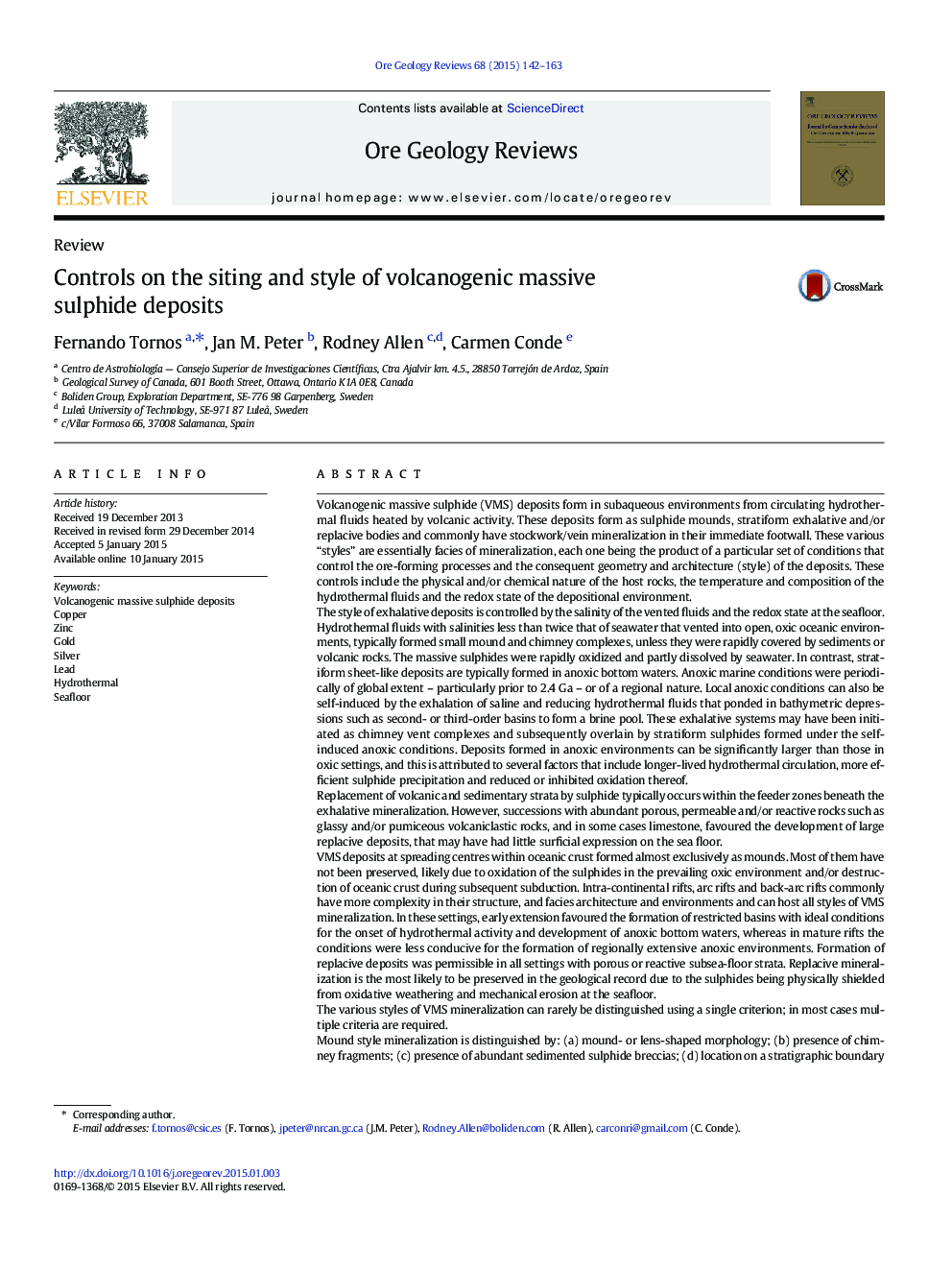| کد مقاله | کد نشریه | سال انتشار | مقاله انگلیسی | نسخه تمام متن |
|---|---|---|---|---|
| 4697354 | 1637236 | 2015 | 22 صفحه PDF | دانلود رایگان |

Volcanogenic massive sulphide (VMS) deposits form in subaqueous environments from circulating hydrothermal fluids heated by volcanic activity. These deposits form as sulphide mounds, stratiform exhalative and/or replacive bodies and commonly have stockwork/vein mineralization in their immediate footwall. These various “styles” are essentially facies of mineralization, each one being the product of a particular set of conditions that control the ore-forming processes and the consequent geometry and architecture (style) of the deposits. These controls include the physical and/or chemical nature of the host rocks, the temperature and composition of the hydrothermal fluids and the redox state of the depositional environment.The style of exhalative deposits is controlled by the salinity of the vented fluids and the redox state at the seafloor. Hydrothermal fluids with salinities less than twice that of seawater that vented into open, oxic oceanic environments, typically formed small mound and chimney complexes, unless they were rapidly covered by sediments or volcanic rocks. The massive sulphides were rapidly oxidized and partly dissolved by seawater. In contrast, stratiform sheet-like deposits are typically formed in anoxic bottom waters. Anoxic marine conditions were periodically of global extent – particularly prior to 2.4 Ga – or of a regional nature. Local anoxic conditions can also be self-induced by the exhalation of saline and reducing hydrothermal fluids that ponded in bathymetric depressions such as second- or third-order basins to form a brine pool. These exhalative systems may have been initiated as chimney vent complexes and subsequently overlain by stratiform sulphides formed under the self-induced anoxic conditions. Deposits formed in anoxic environments can be significantly larger than those in oxic settings, and this is attributed to several factors that include longer-lived hydrothermal circulation, more efficient sulphide precipitation and reduced or inhibited oxidation thereof.Replacement of volcanic and sedimentary strata by sulphide typically occurs within the feeder zones beneath the exhalative mineralization. However, successions with abundant porous, permeable and/or reactive rocks such as glassy and/or pumiceous volcaniclastic rocks, and in some cases limestone, favoured the development of large replacive deposits, that may have had little surficial expression on the sea floor.VMS deposits at spreading centres within oceanic crust formed almost exclusively as mounds. Most of them have not been preserved, likely due to oxidation of the sulphides in the prevailing oxic environment and/or destruction of oceanic crust during subsequent subduction. Intra-continental rifts, arc rifts and back-arc rifts commonly have more complexity in their structure, and facies architecture and environments and can host all styles of VMS mineralization. In these settings, early extension favoured the formation of restricted basins with ideal conditions for the onset of hydrothermal activity and development of anoxic bottom waters, whereas in mature rifts the conditions were less conducive for the formation of regionally extensive anoxic environments. Formation of replacive deposits was permissible in all settings with porous or reactive subsea-floor strata. Replacive mineralization is the most likely to be preserved in the geological record due to the sulphides being physically shielded from oxidative weathering and mechanical erosion at the seafloor.The various styles of VMS mineralization can rarely be distinguished using a single criterion; in most cases multiple criteria are required.Mound style mineralization is distinguished by: (a) mound- or lens-shaped morphology; (b) presence of chimney fragments; (c) presence of abundant sedimented sulphide breccias; (d) location on a stratigraphic boundary (ore horizon); and (e) association with a thin horizon or thicker stratigraphic interval of fine-grained clastic rocks (e.g., shale, mudstone) that accumulated at slow sedimentation rates.Stratiform exhalative mineralization is distinguished by: (a) sheet-like morphology prior to deformation; (b) presence of fine-grained clastic host rocks that accumulated at relatively slow rates (e.g., mudstone); (c) presence of local or extensive planar stratification.Replacive mineralization is characterized by: (a) irregular geometry and distribution of sulphide bodies; (b) gradation from massive sulphides to semi-massive sulphides and disseminated mineralization with relict textures of the host rock; and (c) originally pumiceous, glassy or reactive host rocks emplaced at high depositional rates (mass flow deposits, lavas, carbonate-altered mass flow deposits) or limestone.One deposit or district may comprise two or more of these main styles of mineralization. In many cases the main styles of VMS mineralization present in a particular region can be predicted from examination of the facies architecture and depositional environments of the host succession. Recognition of the style(s) of mineralization that occur in a particular basin or mineral belt enables exploration models to be improved and should influence the strategy of exploration for VMS deposits.
Journal: Ore Geology Reviews - Volume 68, July 2015, Pages 142–163